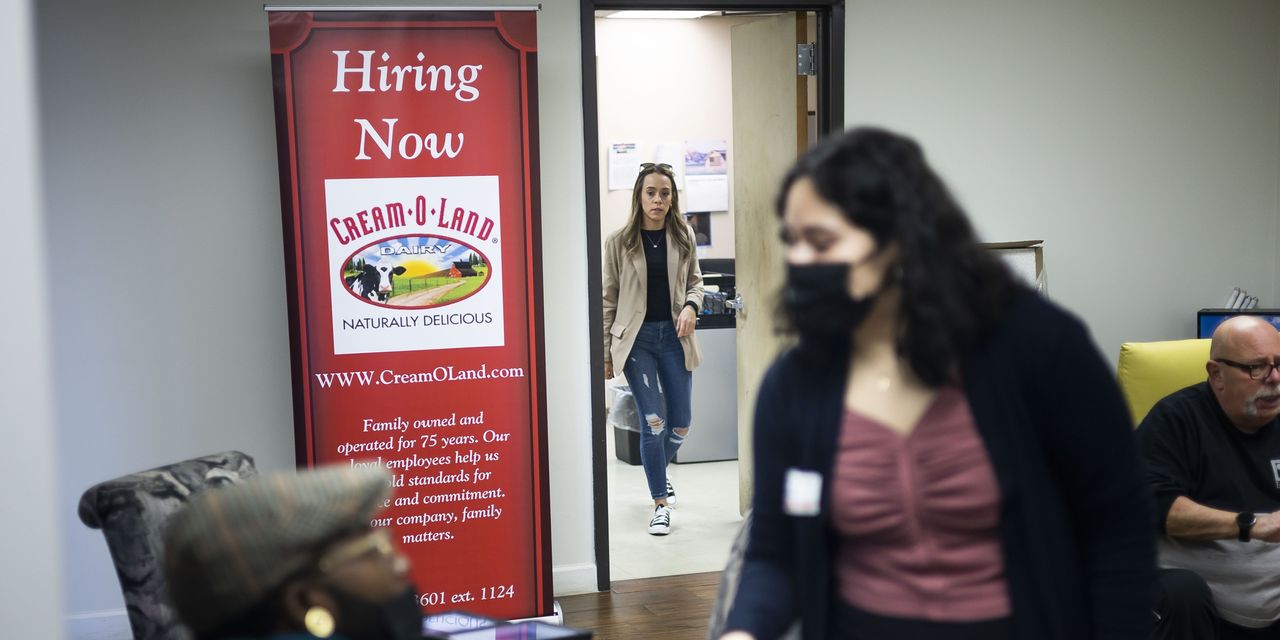
For workers, it is great news: the U.S. labor market is nearing, or may already be at, its ideal state of “full employment.” But for the economy as a whole, it risks introducing a new source of upward pressure on inflation.
Full employment refers to a labor market in which just about anyone who wants a job can get one, without wages and prices rising out of control. It is the ideal of a healthy, steadily growing economy. In theory, once employment passes that level, wage pressures start to build which employers may pass along in prices.
While economists don’t agree on a single definition of full employment, some see signs the U.S. is getting there or may have already passed it: plummeting unemployment and accelerating wage growth.
The Federal Reserve under Chairman Jerome Powell has resisted precisely defining full employment, sometimes called maximum employment. But one guidepost comes from its projections of where the unemployment rate will settle in the long run. In December, most officials thought that was around 4%.
By that measure, the U.S. is already there. In December, the unemployment rate fell to 3.9%, down from 6.7% a year earlier, the Labor Department said last week. Economists surveyed by The Wall Street Journal expect it to reach 3.5% at the end of this year.
Meanwhile, employers added just 199,000 jobs last month, less than half the average monthly gain for all of 2021. Hourly wages rose 4.7% in December from a year earlier, far higher than the 2.9% gain in 2019. Workers are quitting at the highest rate on record, often for higher pay.
On the surface, that suggests there simply aren’t many workers left to hire and that the recovery has run its course. With inflation at a near-40 year high of 7% in December, conditions seem to meet the textbook definition of full employment.
In fact, Sung Won Sohn, a professor of finance and economics at Loyola Marymount University, said the U.S. is above full employment. And he points to anecdotal evidence that higher wages are contributing to higher inflation, even if they aren’t the main driver right now. Last year, Chipotle Mexican Grill Inc. raised prices to offset higher labor costs. The Fed, in a report known as the Beige Book, said this week that, in parts of the mid-Atlantic region, “many firms reported raising wages and passing the higher labor costs through to final prices.”
Dr. Sohn says that for most workers, consumer prices rose faster than their wages over the past year, and that they are now—or will soon at least—pressure their employers to raise their pay to keep up with inflation. In turn, businesses will raise prices further to maintain profit margins.
Dr. Sohn predicts that wages will rise between 5% and 6% this year, faster than his 2022 projection for inflation of between 3% and 4%. “The wage price spiral has begun,” Dr. Sohn said. “Once it starts, it just doesn’t die down on its own.”
Higher wages are good for workers only if they aren’t eaten up by inflation. In theory, if wages grow faster than workers’ productivity, either prices must go up or profit margins must narrow.
The American Bankers Association said this week it expects wages to grow between 4.5% to 5% this year, and that businesses will respond by investing in technology. Such investments typically improve productivity, allowing companies to reduce costs by making more with less. The group believes that inflation will cool to 3% this year as supply-chain bottlenecks ease.
The debate over whether full employment has been achieved hinges largely on the size of the labor force, which was 1.4% smaller, or 2.9 million people fewer, in December than before the pandemic. Are those people gone for good, or will some come off the sidelines and apply for one of the many job openings?
Through August, roughly 2.4 million workers retired early because of the pandemic, according to the Federal Reserve Bank of St. Louis. Most are unlikely to return.
Dr. Sohn thinks some workers have opted to stay home and raise their children while their spouses work. “Their attitudes are totally different about employment,” Dr. Sohn said. “They are really not in a hurry to come back to work.”
If he is right, then labor supply would remain tight, the unemployment rate would continue to fall, and rising wages would pressure inflation as companies compete for workers by boosting pay.
But others think the labor market has more room to run, including Mr. Powell. At his Senate hearing Tuesday for confirmation to a second term, the Fed chairman said the labor market is rapidly approaching or at maximum employment.
Nonetheless, he said inflation is at a near-40 year high of 7% not because of a hot labor market and rising wages, but because of product shortages caused by supply-chain disruptions and stronger demand that resulted from aggressive stimulus.
High inflation does, however, threaten the economy’s ability to stay at full employment, he said. Fed officials believe the labor force may rebound in coming years, allowing healthy growth in employment without labor shortages spurring higher costs. If inflation forces the Fed to raise interest rates sharply, it could short-circuit that recovery in both the labor force and employment, they say.
SHARE YOUR THOUGHTS
Is the U.S. at ‘full employment’? Join the conversation below.
The Fed’s plans to raise interest rates this year could be both a response to a labor market that is achieving full employment and an attempt to help it stay there. “Achievement of maximum employment, by which we really mean continued progress in hiring and in participation, is going to require price stability,” Mr. Powell said.
Some economists point out that the U.S. still has roughly 3.6 million fewer jobs than just before the pandemic. They say the unemployment rate is artificially low because of the depleted pool of job hunters which they attribute to Covid-19, a shortage of child care and virus-related school closures that are keeping many workers on the sidelines. In coming months as vaccination or immunity reduce illness or fear of it and household savings are depleted, workers will return to the labor force, these economists say.
In the previous expansion, unemployment repeatedly fell below levels economists thought would spur inflation without that happening.
Still, there are big questions about the long-term supply of labor. Immigration has fallen sharply and it isn’t clear whether it will recover while some workers may be unable to return to the job because of long-term Covid complications, said Diane Swonk, chief economist at the advisory firm Grant Thornton LLP.
Whether the U.S. is at full employment Is “not an easy question to answer because the virus has distorted so much of the supply” of labor, she said.
—Nick Timiraos contributed to this article.
Write to Josh Mitchell at [email protected]
Copyright ©2022 Dow Jones & Company, Inc. All Rights Reserved. 87990cbe856818d5eddac44c7b1cdeb8








